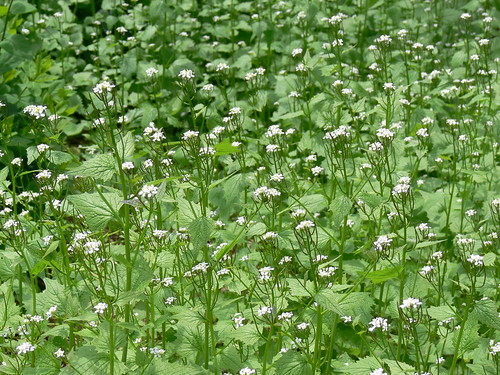Garlic Mustard by archangelm
Another weed that plagues my garden and yard is yet another of the weeds that were introduced in North America. This one was introduced in the 1860s as a culinary herb and for medicinal purposes. However, once outside of Europe it became an invasive species. This weed has a number of common names, but the most common name where I live is garlic mustard, Alliaria petiolata. Garlic mustard, in the mustard family, also became an invasive weed in Africa, India, Sri Lanka, Australia and New Zealand. In Europe as many as 69 species of insects including the larve of some Lepidoptera (butterfly and moth)species feast on garlic mustard, but in other areas of the world garlic mustard has no insect predator. So Garlic mustard, an edible plant for some, has become a noxious weed.
It is a biennial- which means that it takes two years to flower and set seed. Because the first year the leaf pattern is so pretty, when TheGardenLady first saw the plant she let it grow. Unfortunately it looks unattractive when it sends up the tiny flowers. And its leaves smell like garlic and the taproot smells like horseradish.
Garlic mustard has become an invasive plant in areas where it is not a native. Invasive plants threaten local ecosystems which means that they take over and do not allow most native plants to grow. Invasive plants take over where they have few or no natural enemies and out-compete native plants by monopolizing space, soil nutrients, moisture and sunlight and sends out a toxic chemical from its roots that does not allow other plants to grow near it. The toxic chemical is called an allelochemical. Animals like deer eat the plant and spread the seed.
In a small garden one can easily pull the plant out. Try to recognize the pretty whorl of leaves in the first year, so you can pull the plant out when it is young. If you have too many to pull, call your neighbors and friends over for a pulling party. Make your favorite iced drink and tea sandwiches and offer a small prize for the person who collects the most plants – but the garlic mustard plants have to be pulled up with their roots. (see here)
Or if you prefer this weed to eat- you know this is a variation of the Home and Garden TV Show of Love it or Pull it- you can invite your friends for a sampling of Garlic mustard recipes that you have concocted from all the plants you pulled. But first you must tell your friends how much you value their friendship and show this by telling them the nutritious value of garlic mustard which is reputed to be good for your weight, heart, lowering of cholesterol, may help prevent cancer, as well as many other health benefits Then check out some of
the numerous recipes available online like this or this or Eat it to beat it or this.


I think I have this little bugger in my flowerbeds and garden. I really really need to know what the roots look like. I keep pulling up these large carrot type roots that are very often doubled and remind me of what ginsing must look like, and can be rather large clumps. Do you have a picture ofthe root for a mustard garlic weed?